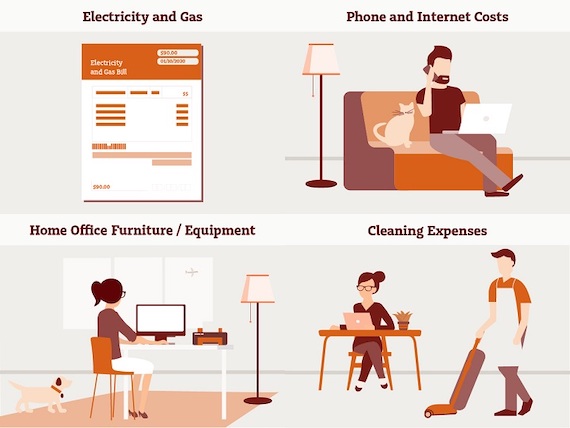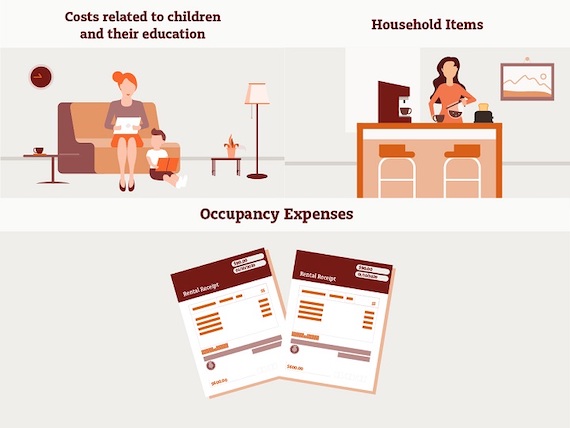Key takeaways
-
The ATO has introduced a new shortcut method for claiming work-related tax deductions until 30 June 2022
-
Under this method, you can claim 80 cents per hour for your additional running expenses that you have incurred
-
You’re not required to keep receipts or calculate the specific costs of items you may have bought during this period, but you will need to keep records of the number of hours you’ve worked.

It’s hard to see the good in COVID but one of the few upsides is that you may be able to claim some tax back for the expenses incurred from running your make-shift home office.
The ATO has introduced a new shortcut method for claiming work-related tax deductions. This temporary shortcut method can be used until 30 June 2022.
Under the method, you can claim 80 cents per hour for your additional running expenses that you have incurred. This covers a whole range of expenses:
-
Electricity and gas expenses associated with heating, cooling, and lighting.
-
Cleaning expenses, phone costs, and internet.
-
Home office furniture, stationery, computers consumables, laptops, printers and tablets.

The shortcut method is simple. All you need to do is calculate the total number of hours you’ve worked from home due to COVID and multiply those hours by $0.80. The final amount is your tax-deductible expense claim for the financial year.
If you decide to sell your home, you may also need to consider any impact that making a working-from-home claim could have on your main residence capital gains tax exemption later.
What you can’t claim
If you’re working from home because of the COVID lockdown, you generally can’t claim:
-
Occupancy expenses such as mortgage interest, rent, insurance and rates.
-
Coffee, tea, milk, and other general household items.
-
Costs related to children and their education.
-
Time spent not working.

Records required
You’re not required to keep receipts or calculate the specific costs of items you may have bought during this period, but you will need to keep records of the number of hours you’ve worked. This could include your Outlook calendar, a timesheet or diary.
Note: when you complete your tax return, you’ll also need to include the reference ‘COVID-hourly rate’ if it is lodged through myGov or your tax agent.
Multiple people working in your home
If there are multiple people working from a single home, they can each claim 80 cents per hour for additional running expenses that they each incur. This includes both members of a couple living together.
More details are available from the ATO.
Case study example
Ben is a full-time employee who started working from home because of the COVID lockdown and needed to buy a new laptop, desk, chair and printer.
Working from home means he’s also spent extra money on gas, electricity, phone and Wi-Fi internet.
Under the shortcut method, Ben can now claim a deduction at the rate of 80 cents per hour for the expenses he incurred as long as he has timesheet style evidence to prove how many hours he’s worked.
Other methods for claiming work expenses
You can still make a claim for working from home under the existing methods, where you calculate all or part of your actual running expenses.
Fixed-rate method
This is known as the 52 cents per work hour method for claiming items such as heating, cooling, lighting, cleaning, and a decline in value of office furniture. The method is available if you have a dedicated work area in your home.
Separately under this method, you can claim the work-related portion of actual phone and internet expenses, stationery and a decline in the value of a computer, laptop or similar device. But you’ll need to keep records of the expenses and be clear about what the personal versus deductible work-related portion of usage is.
Actual cost method
With this method you can claim the reasonable actual work-related portion of all your running expenses.
Unlike the new shortcut method, you’ll need to keep records of all your expenses along with the number of hours you’ve worked from home.
Case study example
Anna is a full-time employee who’s been working from home as a result of the COVID and decided to buy a new laptop and desk chair, and dedicated a spare room at home for work. She also wants to claim some additional gas, electricity, phone and internet costs due to working from home.
Under the fixed-rate method, she can claim the desk chair, gas and electricity under the 52 cents per hour rate. She would then need to work out the decline in value of the laptop, and calculate the work-related portion of the laptop, phone and internet.
Which method?
As you can see from the examples above, there are now three ways of claiming working-from-home expenses. To simplify the terminology, there’s the 52 cents fixed-rate approach, the fixed cost method and the shortcut 80 cents approach.
Which method best suits you—and results in the maximum tax deduction—may depend on variables like how long you’re working at home, the amount of your expenses, and the quality of your record keeping and whether you have a dedicated work space at home.
It may be worth discussing this issue with your tax agent to make sure you get maximum tax benefit with minimal admin workload.
Important information and disclaimer
This article has been prepared by NULIS Nominees (Australia) Limited ABN 80 008 515 633 AFSL 236465 (NULIS) as trustee of the MLC Super Fund ABN 70 732 426 024. NULIS is part of the group of companies comprising Insignia Financial Ltd ABN 49 100 103 722 and its related bodies corporate (‘Insignia Financial Group’). The information in this article is current as at April 2022 and may be subject to change. This information may constitute general advice. The information in this article is general in nature and does not take into account your personal objectives, financial situation or needs. You should consider obtaining independent advice before making any financial decisions based on this information. You should not rely on this article to determine your personal tax obligations. Please consult a registered tax agent for this purpose. Opinions constitute our judgement at the time of issue. The case study examples (if any) provided in this article have been included for illustrative purposes only and should not be relied upon for decision making. Subject to terms implied by law and which cannot be excluded, neither NULIS nor any member of the Insignia Financial Group accept responsibility for any loss or liability incurred by you in respect of any error, omission or misrepresentation in the information in this communication.


